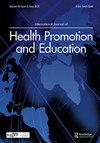Poor cardiorespiratory fitness in first year medical students at a South African University
IF 0.7
Q3 EDUCATION, SCIENTIFIC DISCIPLINES
International Journal of Health Promotion and Education
Pub Date : 2023-10-18
DOI:10.1080/14635240.2023.2261930
引用次数: 0
Abstract
ABSTRACTThe personal health behaviours, including physical activity, of healthcare professionals influence their counselling practices as they relate to non-communicable diseases (NCDs). However, despite the importance of producing healthy, physically active graduates, there are limited data on the physical fitness of future healthcare professionals. This cross-sectional observational study determined the prevalence of below-average fitness in the four components of fitness in first-year university medical students. 152 participants (46 male, 106 female, 20.16 ± 2.69 years) completed cardiorespiratory fitness tests (submaximal step test), flexibility (sit-and-reach test), muscle strength (handgrip), and muscle endurance tests (sit-ups, push-ups). Sex differences were reported using one-way ANOVA or Chi square test and significance was set at p < 0.05. The prevalence (%) of below-average fitness was 69.54% for cardiorespiratory, 25.66% for handgrip strength, 65.79% for sit-ups, 23.03% for push-ups and 7.24% for flexibility. Physical fitness parameters (mean±standard deviation (SD)) were compared between sexes, where it was found that females were more flexible than males (40.61 ± 8.40 cm vs 36.70 ± 9.31 cm, p = 0.012). Males had better handgrip strength (88.96 ± 12.04 kg vs 59.34 ± 10.36 kg, p < 0.001), muscle endurance sit-ups (33.46 ± 9.04 vs 24.48 ± 12.18, p < 0.001) and push-ups (30.28 ± 13.95 vs 24.27 ± 12.35, p = 0.009). First-year medical students have poor physical fitness, notably cardiorespiratory fitness and muscle strength, which are important markers for NCD risk assessment. Tertiary institutions training healthcare professionals should consider developing interventions to improve students’ physical fitness thereby influencing their health, wellbeing, academic performance and future counselling practices.KEYWORDS: Health behaviourphysical activityaerobicstrengthflexibility Disclosure statementNo potential conflict of interest was reported by the author(s).Additional informationFundingThis work was partially supported by the International Olympic Committee [Research Grant for IOC Research Center of South Africa].Notes on contributorsJill BorresenJill Borresen, PhD Sport, Exercise Medicine and Lifestyle Institute (SEMLI) and IOC Research Centre of South Africa, University of Pretoria, Hatfield, Pretoria, 0028, South Africa.Bert CelieBert Celie, PhD Sport, Exercise Medicine and Lifestyle Institute (SEMLI) and IOC Research Centre of South Africa, University of Pretoria, Hatfield, Pretoria, 0028, South Africa.Ria LaubscherRia Laubscher, BCom(Maths) Biostatistics Unit, South African Medical Research Council, Cape Town, Western Cape, 7505, South Africa.Martin BacMartin Bac, M Fam Med, MD Department of Family Medicine, University of Pretoria, Pretoria, 0028, South Africa.Paola WoodPaola Silvia Wood PhD, Department of Physiology and Sport, Exercise Medicine and Lifestyle Institute (SEMLI), University of Pretoria, Pretoria, 0028, South Africa.Tanya CamachoTanya Chantelle de Sousa Camacho, MA Department of Physiology, University of Pretoria, Pretoria, 0028, South AfricaKim NolteKim Nolte, DPhil Department of Physiology and Sport, Exercise Medicine and Lifestyle Institute (SEMLI), University of Pretoria, Pretoria, 0028, South AfricaMarianne SchwellnusMarianne Louise Schwellnus, medical student representative School of Medicine, University of Pretoria, Pretoria, 0028, South Africa.Debashis BasuDebashis Basu, PhD Department of Public Health Medicine, University of Pretoria, Pretoria, 0028, South AfricaMartin SchwellnusMartin Peter Schwellnus, MBBCh Sport, Exercise Medicine and Lifestyle Institute (SEMLI), University of Pretoria and IOC Research Centre of South Africa, Pretoria, 0028, South Africa.南非一所大学医学院一年级学生心肺功能不佳
摘要医疗保健专业人员的个人健康行为,包括身体活动,影响他们与非传染性疾病(NCDs)相关的咨询实践。然而,尽管培养健康、积极锻炼身体的毕业生很重要,但关于未来医疗保健专业人员身体健康的数据有限。本横断面观察性研究确定了一年级医学生在健康的四个组成部分中低于平均水平的健康发生率。152名参与者(男46名,女106名,年龄20.16±2.69岁)完成了心肺功能测试(次最大步幅测试)、柔韧性测试(坐伸测试)、肌肉力量测试(握力)和肌肉耐力测试(仰卧起坐、俯卧撑)。性别差异采用单因素方差分析或卡方检验,p < 0.05为显著性。心肺功能低于平均水平的比例为69.54%,握力为25.66%,仰卧起坐为65.79%,俯卧撑为23.03%,柔韧性为7.24%。性别间体质参数(均数±标准差(SD))比较发现,女性柔韧性优于男性(40.61±8.40 cm vs 36.70±9.31 cm, p = 0.012)。男性握力(88.96±12.04 kg比59.34±10.36 kg, p < 0.001)、肌肉耐力仰卧起坐(33.46±9.04比24.48±12.18,p < 0.001)和俯卧撑(30.28±13.95比24.27±12.35,p = 0.009)较好。医一年级学生的身体素质较差,尤其是心肺功能和肌肉力量,这是NCD风险评估的重要指标。培训医疗专业人员的高等教育院校应考虑制定干预措施,以改善学生的身体素质,从而影响他们的健康、福祉、学习成绩和未来的咨询实践。关键词:健康行为体育活动肌力柔韧性披露声明作者未报告潜在利益冲突。本研究得到了国际奥委会[国际奥委会南非研究中心研究基金]的部分支持。jill Borresen,博士,运动医学和生活方式研究所(SEMLI)和南非国际奥委会研究中心,比勒陀利亚大学,哈特菲尔德,比勒陀利亚,0028,南非。Bert Celie,博士,运动医学和生活方式研究所(SEMLI)和国际奥委会南非研究中心,比勒陀利亚大学,哈特菲尔德,比勒陀利亚,0028,南非。Ria Laubscher, BCom(数学)生物统计单位,南非医学研究理事会,开普敦,西开普省,7505,南非。Martin Bac,医学博士,家庭医学系,比勒陀利亚大学,比勒陀利亚,0028,南非。Paola Silvia Wood博士,比勒陀利亚大学运动医学和生活方式研究所(SEMLI)生理和体育系,比勒陀利亚,0028,南非。Tanya CamachoTanya Chantelle de Sousa Camacho, MA,比勒陀利亚大学生理学系,南非比勒陀利亚,0028;kim NolteKim Nolte,博士,比勒陀利亚大学运动医学与生活方式研究所生理与体育系,南非比勒陀利亚,0028;marianne SchwellnusMarianne Louise Schwellnus,比勒陀利亚大学医学院医学生代表,比勒陀利亚,0028。Debashis Basu,博士,比勒陀利亚大学公共卫生医学系,比勒陀利亚,0028,南非。martin SchwellnusMartin Peter Schwellnus,比勒陀利亚大学体育、运动医学和生活方式研究所(SEMLI)和南非国际奥委会研究中心,比勒陀利亚,0028,南非。
本文章由计算机程序翻译,如有差异,请以英文原文为准。
求助全文
约1分钟内获得全文
求助全文
来源期刊

International Journal of Health Promotion and Education
EDUCATION, SCIENTIFIC DISCIPLINES-
CiteScore
2.30
自引率
10.00%
发文量
69
 求助内容:
求助内容: 应助结果提醒方式:
应助结果提醒方式:


